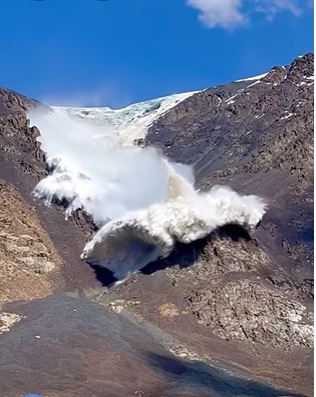Ocean water is advancing miles beneath the “Doomsday Glacier” in Antarctica, making it more susceptible to melting than previously believed, according to new research that performed an X-ray of the vital glacier using radar data from space.
As the relatively warm, saline ocean water encounters the ice beneath the glacier, it induces “vigorous melting” and may lead to an underestimation of global sea level rise projections, according to a study published in the Proceedings of the National Academy of Sciences on Monday.
Approximately the size of Florida, the Thwaites Glacier in West Antarctica is the widest glacier in the world and has earned the moniker “Doomsday Glacier” due to the catastrophic sea level rise that could result from its disintegration.

Furthermore, it is the most precarious and unstable glacier in Antarctica, largely due to the incline of the land beneath it, which permits the ocean to erode its ice.
Thwaites, which is already a 4% contributor to the global sea level rise, is stocked with sufficient ice to cause a rise in sea levels exceeding 2 feet.
Furthermore, it is the most precarious and unstable glacier in Antarctica, largely due to the incline of the land beneath it, which permits the ocean to erode its ice.
Thwaites, which is already a 4% contributor to the global sea level rise, is stocked with sufficient ice to cause a rise in sea levels exceeding 2 feet.
However, due to its dual function as an inherent barrier to the encircling ice in West Antarctica, scientists estimate that its total failure could result in an approximate escalation of 10 feet above sea level—a calamity that would be unbearable for coastal communities worldwide.
Numerous studies have identified Thwaites’s enormous vulnerabilities. The consequences of human-caused global warming on fossil fuels have rendered them “by their fingernails,” according to a study published in 2022.
This recent study introduces an additional concerning element into forecasts regarding its destiny.
An X-ray of the glacier was generated by a group of glaciologists, led by scientists from the University of California, Irvine, using high-resolution satellite radar data collected between March and June of last year.
By doing so, they were capable of constructing a mental image of the progression of Thwaites’ “grounding line,” which signifies the juncture where the glacier emerges from the ocean floor and transforms into a free-floating ice shelf.
Grounding lines are critical to the stability of ice formations and a critical point of weakness for Thwaites; however, their investigation has proven to be challenging.
“Over the course of several months and on a daily basis, this new data set provides us with reliable observations of what is occurring.”
They witnessed seawater exerting pressure beneath the glacier for several miles before retreating in accordance with the cyclical pattern of the tides.
A single centimeter of water inflow is sufficient to “jack up” the glacier’s surface, according to Rignot.
His suggestion was that the term “grounding zone” might be more appropriate than “grounding line,” given that, according to their research, it can shift by nearly 4 miles during a 12-hour tidal cycle.
Rignot stated that the velocity of the seawater, which traverses significant distances in a brief period of time, accelerates glacier thaw because, as soon as the ice melts, warmer seawater replaces freshwater.
He further stated that this process of extensive and massive seawater intrusion will heighten the estimations of sea level rise emanating from Antarctica.
An impartial glaciologist from the University of Colorado Boulder, Ted Scambos, described the research as “fascinating and significant.”
“This discovery reveals a procedure that has not yet been incorporated into models.”
And despite the fact that these results only apply to specific regions of the glacier, he stated that this could cause our forecasts of ice loss to accelerate.
An aspect that remains unresolved is whether the surge of water beneath Thwaites is a recent occurrence or if it has been substantial but unidentified for an extended period of time, according to James Smith, a British Antarctic Survey marine geologist who was not a participant in the research.
Professor of Earth observation at the University of Edinburgh, Noel Gourmelen, remarked that the use of radar data in this investigation was intriguing.
He said that it is ironic that, through expanding satellite capabilities and space travel, we are gaining a deeper understanding of this environment.
What the study’s results imply for the future of Thwaites remains largely unknown, according to Gourmelen, an individual who did not participate in the research.
Furthermore, the extent to which this process is occurring beyond Antarctica is unknown, he told CNN, although it is highly probable that it is occurring elsewhere as well.